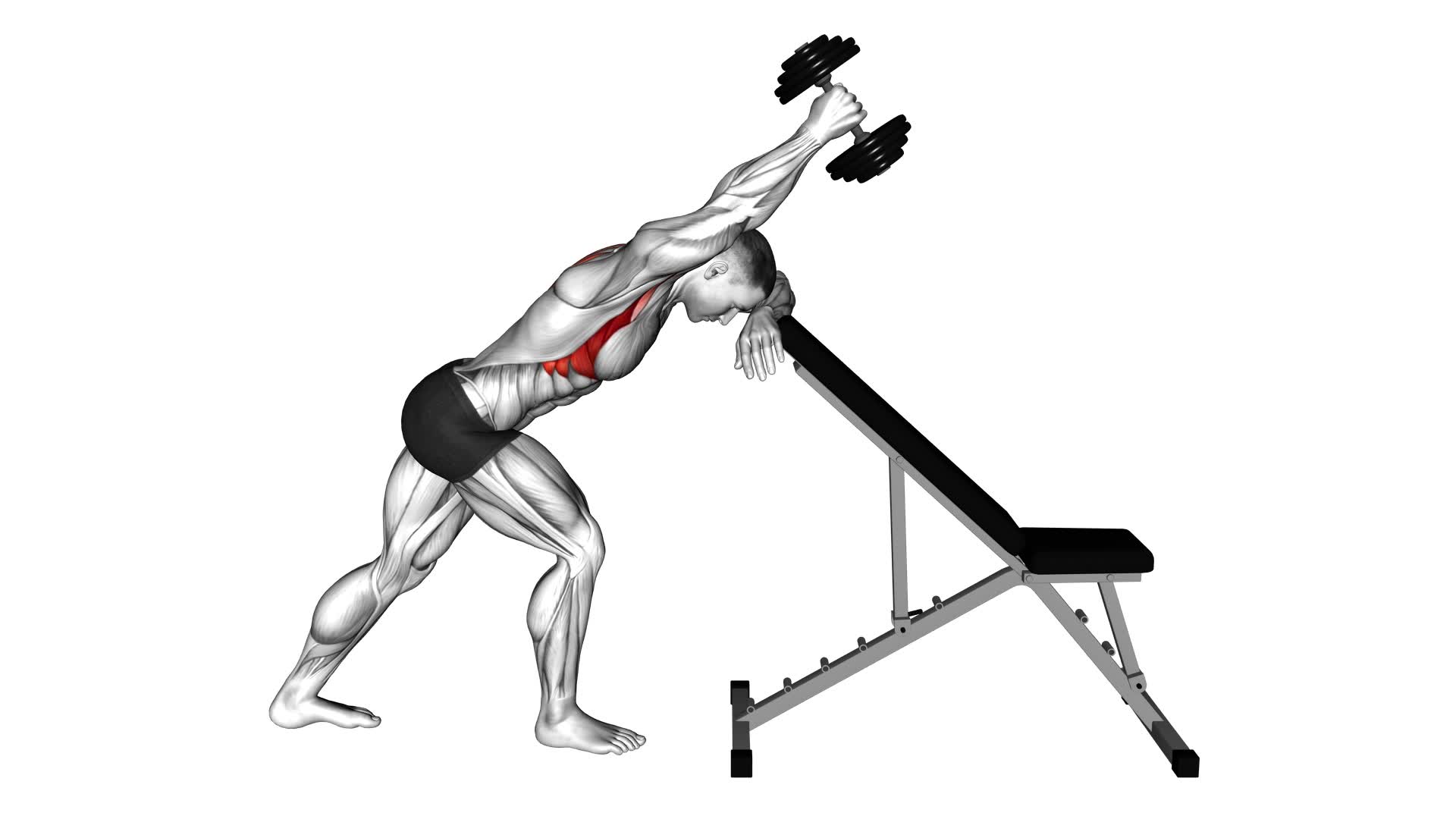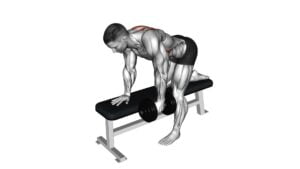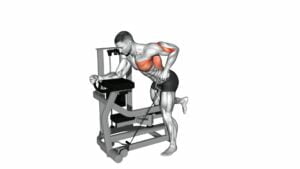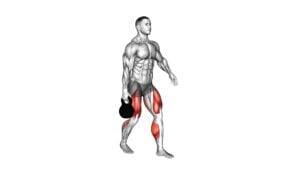Dumbbell Unilateral Scapula Raise (male) – Video Exercise Guide & Tips

Are you looking to strengthen your back and shoulders? In this video exercise guide, we'll show you how to perform the dumbbell unilateral scapula raise.
Watch This Exercise Video
With proper form and technique, you can target those hard-to-reach muscles and improve your posture.
We'll also provide tips for choosing the right weight, variations to challenge yourself, and common mistakes to avoid.
Get ready to maximize your results and take your workout to the next level.
Let's get started!
Key Takeaways
- Maintain a neutral spine throughout the exercise.
- Choose the right weight based on your current strength and fitness level.
- Use variations and progressions to target different muscle groups and increase intensity.
- Avoid common mistakes such as using too much weight, shrugging the shoulders, and raising the arm too high.
Proper Form and Technique
To perform the dumbbell unilateral scapula raise correctly, maintain a neutral spine throughout the exercise. This is essential for injury prevention and optimal muscle activation.
Start by standing with your feet shoulder-width apart and a dumbbell in one hand, palm facing your body. Keep your shoulder blades retracted and depressed throughout the movement.
Begin by raising your arm out to the side, keeping it straight and parallel to the ground. Focus on using your scapular muscles to lift the weight, rather than relying on your arm.
Slowly lower the dumbbell back to the starting position, maintaining control and stability. Engage your core to support your spine and avoid any excessive arching or rounding.
By maintaining proper form and technique, you can maximize muscle activation in your scapular region and minimize the risk of injury. Remember to breathe naturally and avoid any jerky or sudden movements.
Incorporate this exercise into your routine to improve shoulder stability and strengthen your scapular muscles.
Choosing the Right Weight
When choosing the right weight for the dumbbell unilateral scapula raise, continue the discussion from the previous subtopic by considering your current strength and fitness level. To ensure you get the most out of this exercise, it's important to select an appropriate weight that challenges your muscles without compromising your form.
There are a few weight selection considerations to keep in mind. First, start with a weight that allows you to perform the exercise with proper technique. If you find yourself struggling to maintain control or your form begins to falter, it may be a sign that the weight is too heavy. On the other hand, if you can easily complete multiple repetitions without feeling any resistance, the weight may be too light. Aim for a weight that challenges you without sacrificing your form.
Additionally, it's important to adjust the weight based on your fitness level. Beginners should start with lighter weights and gradually increase the load as they become stronger. Intermediate and advanced individuals may require heavier weights to continue challenging their muscles. Listen to your body and make adjustments accordingly.
Variations and Progressions
Try incorporating different variations and progressions into your dumbbell unilateral scapula raise routine to continually challenge and strengthen your muscles. There are several modifications you can make to the unilateral scapula raise exercise to target different areas of the shoulder and back.
One modification is to perform the exercise on an incline bench, which increases the range of motion and places more emphasis on the upper traps and rhomboids. Another variation is to use resistance bands instead of dumbbells, which adds an element of instability and engages more stabilizer muscles.
In addition to modifications, you can also progress the unilateral scapula raise by increasing the weight or repetitions, or by performing the exercise with a slower tempo. Increasing the weight will challenge your muscles to adapt and grow stronger, while increasing the repetitions will improve muscular endurance. Performing the exercise with a slower tempo will increase time under tension and further enhance muscle strength and control.
Incorporating variations and progressions into your dumbbell unilateral scapula raise routine won't only keep your workouts interesting, but also provide you with a well-rounded shoulder and back workout. It will help you target different muscle groups and prevent plateauing. Now that you're aware of the variations and progressions, let's move on to the next section and discuss common mistakes to avoid when performing the dumbbell unilateral scapula raise.
Common Mistakes to Avoid
To ensure proper form and maximize the effectiveness of your dumbbell unilateral scapula raise, it's important to avoid these common mistakes:
- Using too much weight: It's crucial to start with a weight that you can comfortably handle. Using too much weight can lead to improper form and increase the risk of injury.
- Shrugging the shoulders: Many people tend to shrug their shoulders while performing this exercise. This not only takes the focus away from the targeted muscles but also puts unnecessary strain on the neck and traps.
- Raising the arm too high: The goal of the dumbbell unilateral scapula raise is to isolate and activate the muscles of the scapula. Raising the arm too high can shift the focus to the deltoids and reduce the effectiveness of the exercise.
- Failing to engage the core: Your core plays a crucial role in maintaining stability during the dumbbell unilateral scapula raise. Failing to engage the core can lead to poor posture and decrease the effectiveness of the exercise.
- Rushing the movement: It's important to perform the exercise in a slow and controlled manner. Rushing the movement not only increases the risk of injury but also reduces the effectiveness of the exercise.
Tips for Maximizing Results
To maximize your results, focus on maintaining proper form and engaging the targeted muscles during the dumbbell unilateral scapula raise. This exercise is a unilateral exercise, meaning it works one side of the body at a time. Unilateral exercises have several benefits, including improved balance, stability, and strength. They also help to correct muscle imbalances and improve overall muscle coordination.
To incorporate unilateral exercises into your workout routine, start by selecting a variety of exercises that target different muscle groups on each side of the body. For example, you can do dumbbell unilateral scapula raises for your shoulders, single-leg squats for your legs, and one-arm rows for your back.
It's important to remember to start with lighter weights and gradually increase the resistance as your strength improves. Additionally, make sure to perform each repetition with controlled movements and focus on squeezing the targeted muscles.
Frequently Asked Questions
How Many Sets and Reps Should I Do for the Dumbbell Unilateral Scapula Raise?
To properly perform the dumbbell unilateral scapula raise, it's important to focus on sets and reps. Start with 2-3 sets of 10-12 reps for each arm.
This exercise targets the scapula muscles, helping to improve posture and shoulder stability. Remember to maintain proper form throughout, keeping your back straight and shoulders relaxed.
Can I Perform the Dumbbell Unilateral Scapula Raise With Both Arms at the Same Time?
Yes, you can perform the dumbbell unilateral scapula raise with both arms at the same time. However, it's recommended to do them one arm at a time for better focus and control.
This exercise targets your scapular muscles and helps improve shoulder stability and posture. Performing it unilaterally allows for better isolation and activation of the muscles, leading to more effective results.
Additionally, doing the exercise with one arm at a time helps identify any strength imbalances or asymmetries that may exist.
Should I Feel Any Discomfort or Pain in My Shoulders While Performing the Dumbbell Unilateral Scapula Raise?
When performing the dumbbell unilateral scapula raise, it's important to prioritize shoulder mobility and scapula stability. You shouldn't feel any discomfort or pain in your shoulders during the exercise.
If you do experience discomfort, it may be a sign of improper form or excessive weight. Make sure to use a weight that allows you to maintain proper form and engage the targeted muscles without strain.
Consult a fitness professional if you have any concerns.
Is It Necessary to Warm up Before Doing the Dumbbell Unilateral Scapula Raise?
Before performing the dumbbell unilateral scapula raise, warming up is essential. Warming up helps increase blood flow to your muscles and prepares them for the exercise. It also reduces the risk of injury and improves your range of motion.
To perform the exercise correctly, maintain proper form and technique. Keep your back straight, shoulders relaxed, and focus on engaging your scapula muscles.
Remember to start with a lighter weight and gradually increase as you get stronger.
Can I Incorporate the Dumbbell Unilateral Scapula Raise Into My Shoulder Workout Routine?
Yes, you can incorporate the dumbbell unilateral scapula raise into your shoulder workout routine.
It's a great exercise that targets the muscles in your shoulder blades and helps improve stability and posture.
By incorporating other scapula exercises, you can further enhance the benefits of unilateral shoulder exercises.
Adding this exercise to your routine will contribute to a well-rounded shoulder workout and help you achieve your fitness goals.
Conclusion
In conclusion, the dumbbell unilateral scapula raise is an effective exercise for targeting and strengthening the muscles in the shoulder blades.
By maintaining proper form and technique, choosing the appropriate weight, and avoiding common mistakes, you can maximize your results from this exercise.
Remember to progress and vary the exercise to challenge your muscles further.
With consistent practice and careful attention to detail, you can improve your shoulder strength and overall fitness.

Author
Years ago, the spark of my life’s passion ignited in my mind the moment I stepped into the local gym for the first time. The inaugural bead of perspiration, the initial endeavor, the very first surge of endorphins, and a sense of pride that washed over me post-workout marked the beginning of my deep-seated interest in strength sports, fitness, and sports nutrition. This very curiosity blossomed rapidly into a profound fascination, propelling me to earn a Master’s degree in Physical Education from the Academy of Physical Education in Krakow, followed by a Sports Manager diploma from the Jagiellonian University. My journey of growth led me to gain more specialized qualifications, such as being a certified personal trainer with a focus on sports dietetics, a lifeguard, and an instructor for wellness and corrective gymnastics. Theoretical knowledge paired seamlessly with practical experience, reinforcing my belief that the transformation of individuals under my guidance was also a reflection of my personal growth. This belief holds true even today. Each day, I strive to push the boundaries and explore new realms. These realms gently elevate me to greater heights. The unique combination of passion for my field and the continuous quest for growth fuels my drive to break new ground.







